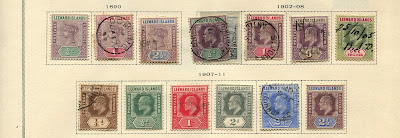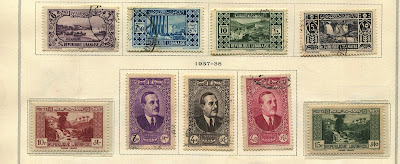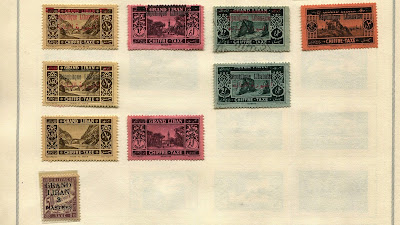1926 Scott 183J 15c chocolate "Ceres"
1920-26 Issue; Perf 12 X 11 1/2
Into the Deep BlueThis is the second of two blog posts for Cape Verde.
Here are the posts for 1877-1938, and the original.
A closer look 1914-1938 & BOB
1000 Reis = 1 Milreis
100 Centavos = 1 Escudo (1913)
1914 Scott 156 30c brown/green "Ceres"
Perf 15 X 14; Chalky Paper
The Scott catalogue through 2011 simplified the typographic 1914-26 "Ceres" issue, lumping the perfs (15 X 14; 12 X 11 1/2) and paper varieties together.
But by 2014, the catalogue's listing for Cape Verde's "Ceres" issues was expanded. There are now "new" Scott numbers for the "Ceres" issues reflecting the more parsed listings.. That is what is presented here. My original Cape Verde post also lists the "old" numbers.
In 1914, the first issue of 16 stamps (Scott 144-159) was released. This issue is characterized by Perf 15 X 14, and chalky paper.
CV ranges from <$1 to $5.
But by 2014, the catalogue's listing for Cape Verde's "Ceres" issues was expanded. There are now "new" Scott numbers for the "Ceres" issues reflecting the more parsed listings.. That is what is presented here. My original Cape Verde post also lists the "old" numbers.
In 1914, the first issue of 16 stamps (Scott 144-159) was released. This issue is characterized by Perf 15 X 14, and chalky paper.
CV ranges from <$1 to $5.
1916 Scott 161 5c deep blue "Ceres"
Perf 15 X 14; Enamel-Surfaced Paper
In 1916, two stamps (1/4c olive brown, 5c deep blue) were issued as Perf 15 X 14, but now on enamel-surfaced paper (Scott 160-61). Both Perf 15 X 14 stamps can also be found with chalky paper. Yes, one will need to discern paper types! ;-)
CV is <$1.
CV is <$1.
1922 Scott 169 3c orange "Ceres"
Perf 15 X 14; Ordinary Paper
Then, to complicate things further, seven stamps (Scott 162-64, 166-68, 172) were issued in 1916 and four stamps (Scott 165, 169-71) were issued in 1922 on ordinary paper. All of these stamps are still Perf 15 X 14. Yes, there is overlap with Perf 15 X 14 stamps on other papers (chalky, enamel), so again, one will need to carefully check the paper type. Fun! ;-)
CV is <$1.
CV is <$1.
1922 Scott 183 5c bright blue "Ceres"
Perf 12 X 11 1/2; Ordinary Paper
The remaining issues (1920-26) are now on Perf 12 X 11 1/2, so an important distinction.
Between 1920-26, 27 stamps (Scott 173-183, 183A-183P) on ordinary paper, Perf 12 X 11 1/2 were issued. One does not need to check the paper, as the Perf 12 X 11 1/2 will distinguish for these denominations ( 1/4c-80c).
CV is <$1 to $2+.
Between 1920-26, 27 stamps (Scott 173-183, 183A-183P) on ordinary paper, Perf 12 X 11 1/2 were issued. One does not need to check the paper, as the Perf 12 X 11 1/2 will distinguish for these denominations ( 1/4c-80c).
CV is <$1 to $2+.
1926 Scott 183R 1e deep blue "Ceres"
Perf 12 X 11 1/2; Glazed Paper
Finally, between 1922-26, six stamps (Scott 183Q-183V) were issued on glazed paper, and Perf 12 X 11 1/2. These stamps, though, are of higher denomination (1e-20e), and therefore do not overlap with the ordinary paper Perf 12 X 11 1/2 varieties of 1920-26.
CV is $1+ - $80.
In summary, the "Ceres" issues are definitely more complicated. The Perf separation into major numbers is welcome. The paper distinctions less so, only because I sometimes struggle with this. The good news is the Scott catalogue is now on par with the Portuguese Afinsa catalogue as far as parsing the "Ceres" issues.
CV is $1+ - $80.
In summary, the "Ceres" issues are definitely more complicated. The Perf separation into major numbers is welcome. The paper distinctions less so, only because I sometimes struggle with this. The good news is the Scott catalogue is now on par with the Portuguese Afinsa catalogue as far as parsing the "Ceres" issues.
1915 Scott 184 115r on 10r green (11 1/2) "King Luiz"
Provisional Issue of 1902 Overprinted in Carmine
Ten stamps of the 1902 provisional issue (which are surcharged) were, in 1915, overprinted "Republica" in carmine, and issued. They were printed 11 /2, 12 1/2, 13 1/2 perf, and some are major numbers, others are minor numbers (Consult Scott). CV is <$1-$2.
1921 Scott 194 1/4c on 1c green; Perf 15 X 14
War Tax Stamps of Portuguese Africa Surcharged
War Tax stamps of Portuguese Africa were surcharged in 1921 for regular postal use. The three stamp denominations can be found Perf 15 X 14 or Perf 12 X 11 1/2. Each Perf type is given a major number. In addition, the Perf 12 X 11 /2 stamps can also be found on enameled paper. CV is <$1-$1.
1921 Scott 198 4c on 10c on 100r bister brown
On Scott 126 Portuguese Africa
Vasco da Gama Issue
Two stamps from the 1913 Vasco da Gama issue (Scott 126 & 127) were surcharged 2c and 4c respectively in 1921. CV is $1+-$2+.
1921 Scott 200 6c on 100r dark blue/blue "King Carlos"
1898 Scott 50 Surcharged
The 1898 Scott 50 was surcharged 6c in 1921. Although it is hard to see with this example, the "Republica" script has an accent over the "U". CV is $2+.
1922 Scott 202 4c on 130r on 75r carmine "King Carlos"
On 1915 Scott 191 Surcharged
In 1922, the 1913-15 Scott 137 & 191-193 were surcharged 4c. A bit of a mess, don't you think? CV is <$1-$1+.
1925 Scott 206 40c on 400r on 2 1/2r brown
On 1902 Scott 79 Surcharged
Newspaper Stamp of 1893
In 1925, two stamps (1902 Scott 78-79) were surcharged 40c. CV is <$1.
1931 Scott 214 70c on 80c bright rose "Ceres"
On 1922 Scott 183P Surcharged
No surcharging of the Ceres stamp issue for Cape Verde was done except for this specimen: 1931 70c on 80c bright rose. CV is $2+.
1934 Scott 233 20e orange "Ceres"
A "new" Ceres issue (new design) was released in 1934 on nineteen stamps. CV is <$1-$20+.
1938 Scott 247 1.75e blue
1938 Vasco da Gama Issue
This common four design Vasco da Gama issue was released for Cape Verde in 1938 on eighteen stamps. CV is <$1-$5.
Air Post 1938 Scott C9 10e magenta
Common Design Type
Likewise this 1938 air post issue (nine stamps) uses a common design. CV is <$1-$5.
Postage Due 1904 Scott J7 100r lilac
In 1904, a ten stamp postage due issue for Cape Verde was released. CV is <$1-$4+.
1911 Scott J15 50r gray brown
Overprinted in Carmine or Green
In 1911, the previous ten stamp PD issue was overprinted "Republica" in carmine and green. CV is <$1-$1+.
1921 Scott J28 13c dull blue
The 1921 PD issue featured this design on ten stamps. I should mention that all the postage due issues (1904, 1911,1921) have a different color for each denomination. CV for the 1921 issue is <$1-$1+.
Newspaper Stamps 1893 Scott P1 2 1/2r brown
In 1893, a newspaper stamp for Cape Verde was released (as well as for many other Portuguese colonies). CV is <$1 for the major number Perf 11 1/2. There also exists Perfs 12 1/2 & 13 1/2.
1925 Scott RA3 15c dull violet & black
Pombal Issue; Common Design Types
Postal Tax Stamps
In 1925, three denomination postal tax stamps were released. As usual, this is a common design type. CV is $1+.
1925 Scott RAJ3 30c dull violet & black
Pombal Issue; Common Design Types
Postal Tax Due Stamps
Finally, also in 1925, three postal tax due stamps were issued. CV is <$1.
Deep Blue
1934 "Ceres" Issue in Deep Blue
Deep Blue (Steiner) has ten pages for the 1914-1938 regular issues and the back-of-the-book issues.
All of the major Scott numbers have a space EXCEPT...
I have the older Steiner page layout for the Ceres issue, which reflects the older non-parsed numbers of Scott circa 2011. What I did was use some quadrilled pages to place extra stamps for the Ceres issue there.
All of the major Scott numbers have a space EXCEPT...
I have the older Steiner page layout for the Ceres issue, which reflects the older non-parsed numbers of Scott circa 2011. What I did was use some quadrilled pages to place extra stamps for the Ceres issue there.
1915 Scott 189 115r on 25r blue green "King Carlos"
Provisional Issue of 1902 Overprinted in Carmine
Out of the BlueWhat is striking for this 1914-38 & BOB era is the remarkably low CV for the stamps. OTOH, there is a certain visual monotony to the issues, as many/most Portuguese colonies had a similar output. Nevertheless, an assiduous collector could sub-specialize in these issues (covers, philatelic history) for not much financial outlay.
Comments appreciated!





















































